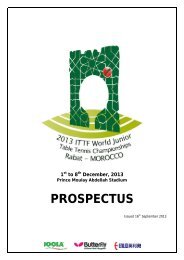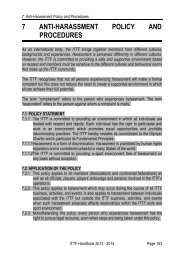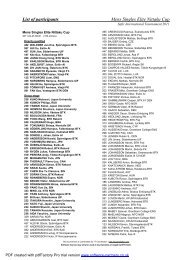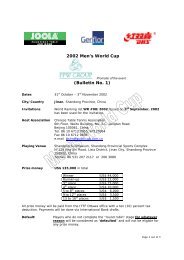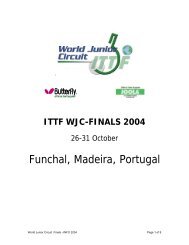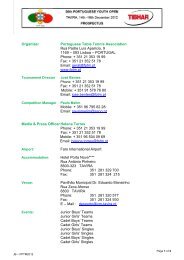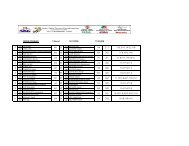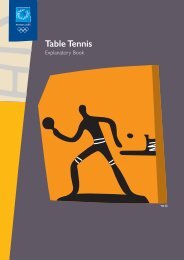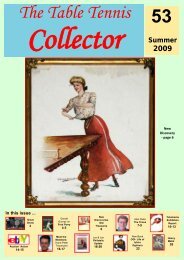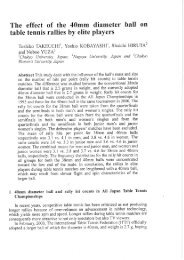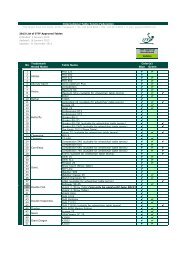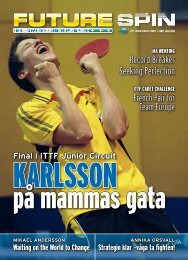You also want an ePaper? Increase the reach of your titles
YUMPU automatically turns print PDFs into web optimized ePapers that Google loves.
In this issue…<br />
THE TABLE TENNIS<br />
Update to Membership List (p2)<br />
The Meaning of Success (p2)<br />
World Championships in Philately<br />
: Part 6 1965 (p3) by Hans-<br />
Peter Trautmann and Winfried<br />
Engelbrech<br />
The Journal of the <strong>Table</strong> <strong>Tennis</strong> <strong>Collector</strong>s’ Society<br />
Surprise for Graham in Hungary<br />
(p5)<br />
Latest from Ebay (p6)<br />
Showcase in Shanghai (p8) by<br />
Chuck Hoey<br />
<strong>38</strong><br />
Summer<br />
2005<br />
The all-time great Richard Bergmann, one of whose signature bats found its<br />
way into the <strong>ITTF</strong> Museum—see page 6. Photo kindly sent by Keith Bowler.<br />
The ETTA Magazine (p10) including<br />
contribution by Gerald<br />
Gurney<br />
Philatelic Pages (p13) by Jan<br />
Nusteleijn and Jos Zinkstok<br />
No. <strong>38</strong> The <strong>Table</strong> <strong>Tennis</strong> <strong>Collector</strong> Page 1
THE HE TABLE TABLE<br />
TENNIS ENNIS<br />
COLLECTOR<br />
OLLECTOR<br />
<strong>38</strong><br />
Summer 2005<br />
Editor:<br />
Graham Trimming<br />
17 Gwendale, Pinkneys Green<br />
Maidenhead, Berkshire, SL6 6SH<br />
England<br />
Tel: +44 (0)1628 636978<br />
email: graham.trimming@virgin.net<br />
Update to Membership<br />
List 2005<br />
Michael Babiun<br />
PO Box 3401, Cary, NC 27519, USA<br />
Tel: +1 (919) 462 3931<br />
Email: mike.babuin@townofcary.org<br />
Interests: TT books (vintage, early any language or<br />
country<br />
Sale/Exchange: Old TT boxed sets.<br />
Acquire: Early books (1902), all editions/versions/<br />
printlines; autographed items.<br />
Fabrice Chantriaux<br />
10 rue des Chevrefeuilles, 5-45130 Saint-Ay, France<br />
Tel: +33 (0) 2<strong>38</strong> 888211<br />
Fax: +33 (0) 2<strong>38</strong> 469429<br />
Email: f.chantriaux@wanadoo.fr<br />
Interests: Old paper items: stamps, postcards, magazines,<br />
books, newspapers, posters.<br />
Sale/Exchange: Stamps, postcards, French stamps.<br />
Acquire: Posters (WC and EC), stamps, old magazines.<br />
Rex Haggett<br />
27 Meadow Close, Stratford-upon-Avon, Warwickshire,<br />
CV37 9PJ, England.<br />
Tel: +44 (0) 1789 269352<br />
Fax: +44 (0) 1789 269352<br />
Email: rex@stratford94.fsnet.co.uk<br />
Website: ourworld.compuserve.com/homepages/<br />
RexHaggett<br />
Interests: Philately.<br />
Jose Ransome<br />
Conifers, Church Lane, Ormesby, Middlesborough, Cleveland,<br />
TS7 9AU, England.<br />
Tel: +44 (0) 1642 322223<br />
Email: ajransome@aol.com<br />
Sale/Exchange: some books.<br />
The Meaning of Success<br />
Book Review—The Meaning of Success (Jon Kaufman)<br />
Subtitled: The Rise and Rise (and imminent demise?) of London Progress <strong>Table</strong> <strong>Tennis</strong> Club<br />
Who has heard of London Progress<br />
<strong>Table</strong> <strong>Tennis</strong> Club? A very familiar<br />
name indeed to English members of<br />
the Society—the remainder of you<br />
will, probably, be asking “who?”.<br />
This is a book about England’s most<br />
successful table tennis club of recent<br />
years. They have been British<br />
League champions for the last seven<br />
years. That success has developed<br />
an arrogance and brashness that has<br />
created enemies in the corridors of<br />
power of English table tennis. Or so<br />
the author of the book, Jon Kaufman,<br />
claims. Kaufman, the unabashed<br />
manager of the club, certainly likes it<br />
that way. He has a vision of the future<br />
of English table tennis built<br />
around large clubs much along the<br />
lines of the European model. He<br />
craves to be likened to Caen TTC in<br />
France but knows he is a long way<br />
short. He attacks the ETTA for their<br />
narrow-mindedness and traditional<br />
style rather than embracing the developmental<br />
style that he thinks could<br />
bring English table tennis up to European<br />
standards. By and large, I<br />
agree will his ideals and vision.<br />
This is a real table tennis book. Its<br />
pages, more than 200 of them, are all<br />
about table tennis and, in particular,<br />
the rise to stardom of Kaufman’s beloved<br />
Progress. All he wants to do is<br />
to get people playing “ping” and then<br />
to win. As he claims throughout<br />
“winning is everything, coming second<br />
is not an option”. And yet, at<br />
times, it seems to be about everything<br />
other than table tennis. It is a<br />
real life drama, played out against the<br />
backdrop of the local ping pong club.<br />
This is far from the normal book on<br />
table tennis; there are no coaching<br />
techniques, there is no appendix of<br />
results, there is hardly a mention of a<br />
single match result. If you like your<br />
books to have lots of pretty pictures,<br />
forget it! There is not a graphic or<br />
photograph to be had.<br />
No, this is a book about people. It is<br />
crammed full with anecdotes about<br />
people. Not all of them are complimentary.<br />
Some of the names have<br />
even had to be changed. It is a book<br />
about an idealogy and, that being so,<br />
includes some political statement.<br />
More than anything it is celebration of<br />
a cultural mix. In a sport dominated in<br />
England by the white middle classes,<br />
London Progress is a club that prides<br />
itself on its varied ethnic mix, taking<br />
kids from the back street estates of<br />
inner London and making something<br />
of themselves. The large majority of<br />
the Progress players are from ethnic<br />
minorities, many are recent immigrants,<br />
some of them having fled war<br />
torn areas of Europe and Africa.<br />
The book is a gripping story—it has<br />
all the parts necessary for a great<br />
film. It is about success. It is about<br />
constant battles against authority and<br />
financial poverty. It is about getting<br />
into scrapes and it is about having<br />
fun, but only after the match has<br />
been won. More than anything it is<br />
about people. Has it got everything—<br />
did I mention there is even a murder?<br />
Kaufman knows what he is talking<br />
about. For some years he worked for<br />
the “enemy”, the ETTA, as London<br />
Region Development Officer. I have<br />
spoken to him on many occasions<br />
and he always makes good sense.<br />
He is passionate about table tennis.<br />
He is even more passionate about<br />
London Progress, “not so much a<br />
club, more of a concept”. It shows in<br />
his writing, and he writes very well.<br />
Entertainingly and challengingly.<br />
I acquired my copy of the book from<br />
Kaufman himself when he visited my<br />
club, along with a bus full of kids from<br />
his Progress club, for a summer tournament.<br />
I wasn’t expecting much. I<br />
was wrong. It is the best read that I<br />
have had in ages and ranks in my<br />
opinion as one of the most readable<br />
table tennis books ever—up there<br />
alongside The Money Player.<br />
The subject matter is perhaps a little<br />
too English to appeal to everyone,<br />
the characters portrayed will not<br />
mean much to non-English readers.<br />
However, the book comes with my<br />
hearty recommendation and can be<br />
obtained for the sum of GBP 10 from<br />
the author himself:<br />
Jon Kaufman<br />
24 Locket Road, Willesden<br />
Middlesex, HA3 7LZ, England.<br />
Tel: +44 (0) 7050 042671<br />
jonk@ufman.fsnet.co.uk<br />
Next issue - publication November 2005 - copy date 1 October 2005<br />
No. <strong>38</strong> The <strong>Table</strong> <strong>Tennis</strong> <strong>Collector</strong> Page 2
World Championships in Philately<br />
Part 6<br />
By Hans-Peter Trautmann and Winfried Engelbrecht<br />
Part 6 of Hans-Peter Trautmann’s and Winfried Engelbrecht’s World <strong>Table</strong> <strong>Tennis</strong> Championships in philately.<br />
Part 1 in the issue 33 began the story in 1950, the year in which special postmarks were used for the first time.<br />
1965 Ljubljana, Yugoslavia<br />
Event Winner(s) Country City<br />
Men’s Singles: Chuang Tse-tung China<br />
Women’s Singles: Naoko Fukazu Japan<br />
Men’s Team: Chang Shih-lin, Chuang Tse-tung, Chou Lan-sun,<br />
Hsu Yin-sheng, Li Fu-jung<br />
Women’s Team: Cheng Min-chih, Liang Li-chen, Li Ho-nan, Lin<br />
Hui-ching<br />
No. <strong>38</strong> The <strong>Table</strong> <strong>Tennis</strong> <strong>Collector</strong> Page 3<br />
China<br />
China<br />
Stamps: Yugoslavia<br />
China<br />
Cancellations: Yugoslavia<br />
China<br />
Ljubljana<br />
Beijing, Shanghai<br />
Stamps issued in Yugoslavia 15.4.65—in blocks of four (and singularly—<br />
overleaf) perforated and single imperforated (below).<br />
And in China 25.4.65.
Covers postmarked from Ljubljana 15.4.65<br />
No. <strong>38</strong> The <strong>Table</strong> <strong>Tennis</strong> <strong>Collector</strong> Page 4
First day covers from the People’s Republic of China 25.4.65 from Peking (above) and Shanghai (below)<br />
owards the end of June your Editor<br />
T and his partner Nita took a weekend<br />
break in the Hungarian capital Budapest.<br />
Knowing that Hungary provided many of<br />
the early World champions, right from its<br />
beginnings in 1926, and that the game<br />
was maintained in Hungary during the<br />
period 1905 to 1920 when most of the rest<br />
of the World forgot about it, Graham<br />
wondered whether the antique shops of<br />
Surprise for Graham in Hungary<br />
the city would provide anything to<br />
augment his collection. Zilch! Nothing!<br />
However, Hungary did present one<br />
antique(!) from the world of table tennis.<br />
Having returned at 7pm from an all-day<br />
tour Graham and Nita decided to have a<br />
pre-dinner drink at a boat-pub, perched on<br />
the Danube, that they had been eyeing up<br />
all weekend. Directed to a table by a<br />
waiter, imagine their surprise when from<br />
the very next table came the salutation<br />
“Hello Graham!” It was none other than<br />
former England international Nigel<br />
Eckersley and his wife Carole, themselves<br />
taking a short break in Budapest after<br />
completing in the European Veterans’<br />
Championships in Bratislava, Slovakia.<br />
It’s a small world!<br />
No. <strong>38</strong> The <strong>Table</strong> <strong>Tennis</strong> <strong>Collector</strong> Page 5
Latest from Ebay<br />
One of the best sources of items to augment collections of any sort is the<br />
internet auction giant Ebay. He is a selection of some of the better items<br />
that have been traded on Ebay since the last issue of this journal.<br />
Two more “signature” bats have found their way also to the <strong>ITTF</strong><br />
Museum and I never cease to be staggered at the high prices<br />
these items command. The Richard Bergmann bat (below left) was<br />
made by Dobbykraft. It sold for GBP 135.<br />
This was not so much as the GBP 175 paid for the Miklos Szabados<br />
bat made by Slazengers, probably in the 1930s. The bat has<br />
been well used and the blue rubber displays quite a lot of wear.<br />
However, even these prices are dwarfed by the USD 405 paid by a<br />
collector for the Stiga Flisan (named after Tage Flisberg) bat made<br />
in Sweden in the 1950s. A similar bat was featured in <strong>Collector</strong> no.<br />
32 having been acquired by the <strong>ITTF</strong> Museum for almost the same<br />
price. However, you might also remember that USD 788 was paid<br />
for the one featured in the last issue. How many of you are now<br />
scurrying around in your attics hoping to find that item that may be<br />
worth oh! so much?<br />
www.ebay.com<br />
Pictured left is one of the more unusual<br />
items to have appeared on Ebay. I apologise<br />
that the photo is not so good. The<br />
seller failed to get it uploaded onto Ebay so<br />
this is a picture that was emailed to me.<br />
It is a bat in a presentation case that has a<br />
leather exterior, a plush maroon velvet<br />
base and a scarlet lining to the lid. There is<br />
a gilt manufacturer’s stamp “D. George<br />
Collins Manufacturing Silversmith, 118<br />
Newgate Street, London. On the bat is a<br />
hallmarked silver shield inscribed “Ping<br />
Pong in Den of Lions, Brighton, 8 March<br />
1902 Won by A.C. Barnett”. The shield is<br />
surmounted by a lion.<br />
The occasion was a game of table tennis<br />
played in a cage of eleven lions at the Hippodrome,<br />
Brighton, before an audience of<br />
2,000 spectators.<br />
<strong>Table</strong> <strong>Tennis</strong> and Pastimes Pioneer, in its<br />
edition of 15 March 1902 described it thus:<br />
“BRIGHTON.—A sensational match took<br />
place on Saturday night at the Brighton<br />
Hippodrome when two local gentlemen,<br />
named E.W. Barnett and H.W. Izod, played<br />
a game for £50 a side in a cage in which<br />
there were eleven lions. The former finally<br />
won the game, the lions taking but little interest<br />
in it. The balls used were subsequently<br />
distributed among the audience as<br />
momentoes of the exhibition.”<br />
This story is also recounted in Gerald Gurney’s<br />
The Early Years and the Ebay item<br />
includes a newspaper cutting giving full details<br />
of the event. This item of great historical<br />
interest found its way to the <strong>ITTF</strong> Museum<br />
for GBP 160.<br />
No. <strong>38</strong> The <strong>Table</strong> <strong>Tennis</strong> <strong>Collector</strong> Page 6
Details of inscription of<br />
Ealing trophy (right).<br />
The seller described the above item, acquired by the <strong>ITTF</strong> Museum<br />
for USD 49, as a wooden sewing box in the shape of a ping pong<br />
table. The halves of the table open to reveal storage. There is a<br />
picture in one corner of a lady sewing and the legend “Rdo. de<br />
Mallorca”, meaning souvenir from Mallorca. A very similar (if not<br />
practically identical apart from the sewing lady) appears on the Museum<br />
website described as a handmade humidor in fine polished<br />
walnut.<br />
The only other item this issue not acquired by the Museum. This<br />
1902 McLoughlin Bros boxed set with its folding wooden net base<br />
and collection of five battledores (presumably four at most being<br />
originals) raised USD 235 for its previous owner in the USA. The<br />
wooden box is leather covered and the words “<strong>Table</strong> <strong>Tennis</strong>” appear<br />
is gold leaf. Included with the rules is a sheet for care and<br />
feeding of vellum!<br />
In the last issue I suggested that trophies from the<br />
1902 era were rare. I featured a rather plain one<br />
then. Here is a much more beautiful example with<br />
some provenance also. The inscription reads<br />
“<strong>Table</strong> tennis championship of Ealing Ladies Singles<br />
Challenge Bowl presented by H.C. Green Esq<br />
Mayor of Ealing 1901-2. Won by Miss M.M. Read<br />
March 5th 1902. Like the Brighton match in the lions’<br />
den, the results of this event were also recorded<br />
in the final edition of TT&PP. The Museum<br />
acquired this beautiful object for GBP 175.<br />
Easily recognizable as being Bussey’s by its familiar<br />
twisted medtal net posts, this c. 1902 set made<br />
its way to the Museum for GBP 83. The table cloth,<br />
beautiful though it is, was not included in the sale!<br />
This Victorian pencil case was<br />
twinned with another that had nothing<br />
to do with our precious game. The<br />
picture is poor because the transfer<br />
design on the lid had suffered considerable<br />
damage. The pair became the<br />
property of the Museum upon the<br />
exchange of GBP 35.<br />
No. <strong>38</strong> The <strong>Table</strong> <strong>Tennis</strong> <strong>Collector</strong> Page 7
T<br />
Showcase in Shanghai<br />
The most exciting development for all table tennis collectors and lovers of history<br />
and memorabilia recently has been the creation of the <strong>ITTF</strong> Museum in<br />
Lausanne, Switzerland. Although the Museum itself is not yet open to the public,<br />
many of the best exhibits made their debut in the public arena at the recent<br />
World Championships in Shanghai, China. Chuck Hoey, the man whose many<br />
hours of hard toil brought this to fruition, tells us the story in his own words.<br />
he recent World Championships in Shanghai featured<br />
the first stop on the LIEBHERR <strong>ITTF</strong> Museum<br />
Tour, a celebration of <strong>Table</strong> <strong>Tennis</strong> heritage. Though an<br />
enormous amount of work for only a one-week exhibit,<br />
the visitors were clearly impressed by the dazzling array<br />
of historical <strong>Table</strong> <strong>Tennis</strong> items in a 700 square meter<br />
display.<br />
Partial view of the Technical exhibit area in the Shanghai exhibit<br />
Organization<br />
The exhibit was presented in 3 sections: Technical, focusing<br />
on the evolution of <strong>Table</strong> <strong>Tennis</strong> and its equipment;<br />
Cultural, showing the impact of <strong>Table</strong> <strong>Tennis</strong> on world<br />
cultures; and <strong>ITTF</strong>/Sport, an illustrated timeline history of<br />
the <strong>ITTF</strong>, and the Hall of Fame. The exhibit also included<br />
a small theatre where films of vintage matches could be<br />
viewed, and the computer <strong>Table</strong> <strong>Tennis</strong> game from the<br />
<strong>ITTF</strong> homepage.<br />
The display cases, specially constructed in Shanghai for<br />
this exhibit, were augmented by large background structures<br />
with attached textiles and interior lighting. Designs<br />
from the <strong>ITTF</strong> Museum collection were printed on the textiles.<br />
Sample of the printed textile structures<br />
Exhibits<br />
By Chuck Hoey,<br />
Curator <strong>ITTF</strong> Museum<br />
Because <strong>Table</strong> <strong>Tennis</strong> is the national sport of China, I felt<br />
an emphasis on the technical aspects of the sport was<br />
appropriate. Probably the most important exhibit was the<br />
very first game of <strong>Table</strong> <strong>Tennis</strong>, made in England in 1890.<br />
This presented some security issues but the visitors respected<br />
the protective barrier.<br />
The first game of <strong>Table</strong> <strong>Tennis</strong>, D.Foster, England 1890<br />
The many bat exhibits were also popular, with a demonstration<br />
of an evolution from the earliest rackets to modern<br />
times.<br />
Visitors crowded around one of the bats exhibits<br />
No. <strong>38</strong> The <strong>Table</strong> <strong>Tennis</strong> <strong>Collector</strong> Page 8
A Walk Through Time<br />
A favourite exhibit among the spectators was the 16- metre<br />
illustrated <strong>ITTF</strong> Timeline History, which showed photos<br />
of all the World and Olympic singles champions,<br />
named the Swaythling and Corbillon Cup winners, as well<br />
as <strong>ITTF</strong> Presidents, significant rules changes and other<br />
major milestones in the history of <strong>Table</strong> <strong>Tennis</strong>. Many<br />
people were observed pointing at the Timeline, a measure<br />
I use to assess an exhibit's success. The 12-metre<br />
<strong>ITTF</strong> Hall of Fame exhibit was also a crowd favourite.<br />
Part of the 16-metre illustrated <strong>ITTF</strong> Timeline History<br />
Cultural Exhibits<br />
The Ping Pong Diplomacy tribute was also much enjoyed<br />
by the visitors, though some were not accustomed to seeing<br />
the revered Chairman Mao depicted in caricature<br />
style. Other cultural exhibits included an art gallery, a Disney<br />
& Comicbook exhibit for the children and young at<br />
heart, and a special exhibit on women in <strong>Table</strong> <strong>Tennis</strong>.<br />
Honouring the Ping Pong Diplomacy era, 1971-72<br />
Victor Barna and the Swaythling Club<br />
Several years ago Susie Barna gave me 15 medals that<br />
Victor won in various competitions in England. I promised<br />
her then that someday I would make a tribute to Victor,<br />
and now this has become a reality, entitled "Victor Barna—His<br />
Legend Lives On". His amazing record of 40<br />
World Championship medals, 22 of which were gold, and<br />
5 men's singles titles, will never be equaled.<br />
Diane Rowe, President of the Swathling Club International<br />
(SCI), cooperated with this exhibit by loaning the<br />
Victor Barna Cup and Richard Bergmann award and<br />
other SCI materials.<br />
Computer Game<br />
The <strong>ITTF</strong> computer game was a great attraction, with the<br />
8 computers nearly in constant use by fans young and<br />
old.<br />
Young visitors enjoyed the <strong>ITTF</strong> <strong>Table</strong> <strong>Tennis</strong> computer game<br />
Donations<br />
Thanks to our good friend Han Sang Kook, three great<br />
Korean champions donated their bats to the <strong>ITTF</strong> Museum,<br />
securing their place in the <strong>ITTF</strong> Hall of Champions:<br />
Ryu Seung Min, winner of the Men's Singles Gold in Athens;<br />
Hyun Jung Hwa, World and Olympic Champion, and<br />
Yoo Nam Kyu, Gold Medalist at the 1988 Olympics.<br />
These bats were exhibited in Shanghai and drew much<br />
attention. I ask all of our Champions to donate their bats<br />
so they can be honoured in the Hall of Champions at the<br />
<strong>ITTF</strong> Museum in Lausanne.<br />
Bats donated by Korean World & Olympic Champions<br />
So many people to thank, especially our sponsor<br />
LIEBHERR for their support, the Shanghai Organizing<br />
Committee, our wonderful volunteers, and all the support<br />
staff, whose enthusiasm, hard work and dedication<br />
helped to make the exhibit possible.<br />
Virtual Tour<br />
The <strong>ITTF</strong> Museum website now offers a virtual tour of the<br />
Shanghai exhibit: www.ittf.com/museum<br />
<strong>Table</strong> <strong>Tennis</strong> is the first sport to create a museum in the<br />
Lausanne Olympic community. I encourage all to do your<br />
part in making the <strong>ITTF</strong> Museum a world-class success.<br />
Contact the curator by e-mail at:<br />
museum@ittf.com or by Fax at +41-21-340-7096<br />
No. <strong>38</strong> The <strong>Table</strong> <strong>Tennis</strong> <strong>Collector</strong> Page 9
The ETTA Magazine<br />
The page opposite features a number of extracts from the official magazine of the English <strong>Table</strong> <strong>Tennis</strong> Association<br />
from the late 1930s imaginatively entitled ….. <strong>Table</strong> <strong>Tennis</strong>. They have been kindly submitted for publication<br />
by Gerald Gurney. As a postscript to the article he wrote to accompany these (below right) Gerald enquired<br />
whether anyone knew when the magazine was first published. That got me scrambling up in my cabinet<br />
where I keep all my table tennis memorabilia and into the many files of magazines (I was fortunate to acquire<br />
the entire collection of Terry Vance at 2001 auction and I am now missing only a few copies and all those are<br />
pre-1950). This then prompted the piece I have written (below) about the various incarnations of the ETTA<br />
magazine through the years—GT.<br />
f course, we are all aware of the<br />
O nine issues of <strong>Table</strong> <strong>Tennis</strong> and<br />
Pastimes Pioneer, published between<br />
January and March 1902, and<br />
which is now reproduced in full on the<br />
<strong>ITTF</strong> Museum website.<br />
What is less certain is when the next<br />
magazine was published. The earliest<br />
magazine in my collection is <strong>Table</strong><br />
<strong>Tennis</strong> Illustrated vol. II, no. 5<br />
from October 1931. It claims to be<br />
published with the authority of the<br />
ETTA, the TTAW (Wales) and the<br />
IFSTTA (Ireland). It claims also to be<br />
the only official magazine devoted to<br />
table tennis and, as if to prove it, contains<br />
articles from such luminaries as<br />
the Hon. Ivor Montagu, C. Corti<br />
Woodcock and H.M. Bunbury<br />
(Chairman, ETTA). It was registered<br />
at Stationer’s Hall and had a distinct<br />
north-west bias with many of the advertisements<br />
being from the Manchester<br />
area. I think we can safely<br />
assume that this magazine must<br />
have commenced in 1930.<br />
Next in my collection is the March 5,<br />
1932 edition of The <strong>Table</strong> <strong>Tennis</strong><br />
World. My only example is vol. 1, no.<br />
9 and as it is a fortnightly publication<br />
is should be safe to assume that this<br />
started in the autumn of 1931. The<br />
proprietor and editor was the England<br />
international Eric Findon.<br />
Now the answer to Gerald’s question.<br />
<strong>Table</strong> <strong>Tennis</strong>, the official organ of the<br />
ETTA was first published on 22 November<br />
1936. I am not fortunate<br />
enough to have the first issue in my<br />
collection but I do have number two<br />
and over twenty others pre-WW2.<br />
Each volume was eight issues and<br />
initially each issue was eight pages.<br />
For volume 3, in October 1937, the<br />
format changed to sixteen pages inside<br />
a cover. This format continued<br />
for the two remaining years before<br />
war intervened.<br />
The re-emergence after the war<br />
brought a new style. There was a<br />
smaller format—only just over half its<br />
original size. However, the paper was<br />
glossier, the cover contained some<br />
colour but the number of inside<br />
pages remained sixteen.<br />
Volume 8 in the autumn of 1949<br />
brought an increase in size but still<br />
not quite as big as the original and<br />
still the same sixteen pages. The<br />
number of pages steadily increased<br />
to twenty-eight (plus the cover) until<br />
bang!—October 1966 and a totally<br />
different style.<br />
This was the start of <strong>Table</strong> <strong>Tennis</strong><br />
News with numbering starting again<br />
from one. At first this was in the style<br />
more of a newspaper rather than<br />
magazine and it was folded horizontally<br />
for distribution. All the colour<br />
was gone in a more austere publication.<br />
The first issue began with the<br />
following statement: “In an honest<br />
endeavour to keep faith by providing<br />
a news service, whilst at the same<br />
time working within the narrow confines<br />
of a budget squeeze no less<br />
acute than Mr. Wilson’s, the <strong>Table</strong><br />
<strong>Tennis</strong> News is launched as an ETTA<br />
publication”. [Mr. Wilson was British<br />
Prime Minister at the time]. It goes on<br />
to report that the 1966 European<br />
Championships, held in England, had<br />
been a financial failure.<br />
<strong>Table</strong> <strong>Tennis</strong> News re-emerged two<br />
years later with its seventeenth issue<br />
in a style more akin to a magazine. It<br />
more closely resembled its current<br />
size, was of twenty pages including a<br />
cover, and re-introduced a small<br />
splash of colour into its title banner.<br />
The May 1970 issue dealt the final<br />
death blow to articles appearing on<br />
the front cover and ever since this<br />
has been the preserve of photographic<br />
images. The front cover received<br />
another makeover in October<br />
Gerald writes:-<br />
Some time ago I came across a<br />
short run of 1930s magazines; these<br />
were published (with 16 pages) from<br />
October to May, under the editorship<br />
of J.W.A. Connolly, sports writer of<br />
the Sunday Express, and cost only<br />
3d (less than 1.5 pence), and, most<br />
remarkably, were “available from all<br />
newsagents”.<br />
They make fascinating reading—not<br />
least for the advertisements: Jaques<br />
tournament tables, “the most perfect<br />
in the world”, and Ayres “super<br />
championship” tables could be<br />
bought for less than £10. Barna<br />
“master rackets—Beware of imitations”<br />
were 3s/9d (less than 20<br />
pence), and Meteor three-piece balls<br />
were 2s/6d (12.5 pence) a dozen.<br />
I have selected a few items to give a<br />
taste of those early days.<br />
1983 and again in November 1985<br />
since when there have been several<br />
minor modifications and updates to<br />
reach the glossy publication it is today.<br />
Nowadays <strong>Table</strong> <strong>Tennis</strong> News is a<br />
colourful magazine of 36 pages plus<br />
the cover but for glossiness is not in<br />
the same league as its <strong>ITTF</strong> counterpart<br />
<strong>Table</strong> <strong>Tennis</strong> Illustrated (does<br />
the <strong>ITTF</strong> know that this is a secondhand<br />
name dating from 1931?).<br />
There have been other table tennis<br />
magazines in England. The <strong>Table</strong><br />
<strong>Tennis</strong> Review, edited by 1931 England<br />
international Arthur Waite, ran<br />
from about 1946 to at least 1955. It<br />
had a smaller format than the ETTA<br />
publication but contained a large<br />
number of new items and articles of<br />
great interest. Then between 1980<br />
and 1982 there was the monthly <strong>Table</strong><br />
<strong>Tennis</strong> available from newsagents<br />
across Britain.<br />
No. 35 <strong>38</strong> The <strong>Table</strong> <strong>Tennis</strong> <strong>Collector</strong> Page 10
The items on this page have been supplied by Gerald Gurney. The article<br />
below right had me wondering whether they ever did manage a museum<br />
exhibition at the 19<strong>38</strong> World’s. It couldn’t have matched the recent one in<br />
Shanghai (see previous pages). My collection of magazines includes the<br />
March 19<strong>38</strong> issue with a report of the World Championships—but no mention<br />
is made of an exhibition—GT.<br />
No. <strong>38</strong> The <strong>Table</strong> <strong>Tennis</strong> <strong>Collector</strong> Page 11
The Changing Face of <strong>Table</strong> <strong>Tennis</strong> (News)<br />
The ETTA magazine has grown up<br />
over time. Pictured here are some of<br />
its major incarnations:<br />
Clockwise from top left:<br />
1936—8 pages for the first volume;<br />
19<strong>38</strong>—a doubling to 16 pages and a<br />
stiffer cover;<br />
1946—post-war cover colour introduced<br />
but a smaller format;<br />
1949—back to a larger format and a<br />
style that would last many years;<br />
1966—the austere newspaper format<br />
to save costs; the same cover<br />
design was used for the 1968 reversion<br />
to the standard size;<br />
1980—typical of the time and an<br />
English hero adorns the cover;<br />
1989—another English hero depicted<br />
on another design that lasted<br />
many years;<br />
2005—in the centre, bang up to date<br />
with the current May 2005 issue.<br />
No. <strong>38</strong> The <strong>Table</strong> <strong>Tennis</strong> <strong>Collector</strong> Page 12
Philatelic Pages<br />
Jan Nusteleijn and Jos Zinkstok continue the regular contribution<br />
about table tennis stamps, post marks and other items of philatelic interest.<br />
Guinee Bissau: 2004 Summer Olympics<br />
in Athens. Sheet with 6 different<br />
stamps and souvenir-sheet pictured<br />
Ryu Seun-Min (South Korea) winner<br />
of gold medal Men’s Singles and<br />
Zhang Yining (China) winner of gold<br />
medal Women’s Singles.<br />
Stamps, Vignettes and Postcards<br />
Rep. of Guinea: 2004.<br />
They look ahead to the Olympic Games in Beijing 2008<br />
China: vignet 1997.<br />
Shanghai Sports Games<br />
pictured one stamp issue:<br />
3rd National Sports Games<br />
1975 Michel no. 1248<br />
Please send your contributions for<br />
the philatelic pages to:<br />
Jos Zinkstok<br />
Neckarstraat 8<br />
NL-9406 VN ASSEN<br />
The Netherlands<br />
Email: j.zinkstok@poveia.nl<br />
Serbia: 2005.<br />
50 th Anniversary of Montenegro<br />
<strong>Table</strong> <strong>Tennis</strong> Federation.<br />
Austria: 2004 collective sheet with 20<br />
different stamps. Personalized<br />
stamps with Austrian army sportsmen.<br />
Names of the TT players: Werner<br />
Schlager, Liu Jia and Chen Weixing.<br />
No. <strong>38</strong> The <strong>Table</strong> <strong>Tennis</strong> <strong>Collector</strong> Page 13
Pakistan: 9th SAF Games Islamabad<br />
29-03-2004.<br />
Sheet of 16 stamps with several<br />
sports in different designs.<br />
China: WTTC Shanghai 2005.<br />
Sheet with 8 identical stamps and<br />
different tabs to commemorate the<br />
event.<br />
North Korea: 2005.<br />
Souvenir-sheet (3 different) with Mao-Tse-Tung, Jan Ove Waldner, Zhang Yining, Pak Yung Sun, Wang Liqin, Werner<br />
Schlager perforated and imperforated. Also issued in booklets and on First Day Cover.<br />
North Korea: 20-12-2004.<br />
Sheet of 8 stamps (announcement<br />
TTC no. 37) overprinted names of<br />
Olympic Champions (no TT players)<br />
and Moscow 1980 Salute Beijing<br />
2008 in silver and gold.<br />
China: postcard Shanghai WTTC<br />
2005 with Yin Yin (mascot of the tournament)<br />
in green.<br />
All stamps showed at 100% and sheetlet and sheets at 50% or 25%<br />
North Korea: 2005.<br />
Postcard issued in set of 6 (one<br />
example above—issued with and<br />
without overprint).<br />
No. <strong>38</strong> The <strong>Table</strong> <strong>Tennis</strong> <strong>Collector</strong> Page 14
Serbia: 11-07-2003.<br />
46th European Youth Championships<br />
held in Novi Sad.<br />
Japan: 18-10-2004.<br />
17th Nenlympic<br />
City: Kiryu.<br />
China: 02-01-2005.<br />
Master <strong>Table</strong> <strong>Tennis</strong> Games<br />
City: Sozhou.<br />
Italy: 19-02-2005.<br />
Filatelic Sport Festival in Bergamo.<br />
Cancellations<br />
China: Olympic Games Athens 22-08-2004.<br />
Gold medal of Zhang Yining is the 100 th gold medal in the Summer Olympic<br />
Games (cancellation left) and Ma Lin/Chen Qi won the gold medal in Men’s<br />
Doubles (right). Cancellation of City Nan Tong (residence of Chen Qi).<br />
China: Olympic Games Athens 2004.<br />
Ji Nen post office triumph cancellation<br />
for 100 th gold medal won by<br />
Zhang Yining (left part) during the<br />
Olympic Games since 1984.<br />
Japan: 23-10-2004.<br />
59th National Athletic Meeting<br />
City: Kasukabe.<br />
Croatia: 19-01-2005.<br />
The 9th Croatian Open in Zagreb.<br />
Japan: 30-04-2004.<br />
28th World Stamp Show.<br />
City: Asakusa.<br />
Japan: 13-11-2004.<br />
4th National Paralympics<br />
City: Gyoda.<br />
Italy: 28-01-2005.<br />
21st European Youth Top 12 held in<br />
Molfetta.<br />
The Netherlands: 06-01-2005.<br />
Redmeter N.T.T.B. – Netherlands <strong>Table</strong>-<strong>Tennis</strong> Association.<br />
Office: City of Zoetermeer – colour red-orange.<br />
No. <strong>38</strong> The <strong>Table</strong> <strong>Tennis</strong> <strong>Collector</strong> Page 15
France: 09-02-2005. Redmeter Office Central League in Selbris printed in blue.<br />
48th World <strong>Table</strong>-<strong>Tennis</strong> Championships held from 29th April to 6th May in Shanghai - China<br />
2 cancellations on a special cover to announce the event. Colours: red and black. Picture postmark of Shanghai <strong>Table</strong><br />
<strong>Tennis</strong> Gymnasium.<br />
48th WTTC cancellation in red, blue<br />
and black in 31 and 35 mm.<br />
Cancellation in black of City: Jinan<br />
Issued by Wulumugi Post-Office: Triumphal<br />
cancellation in honour of the<br />
5 cups they won at the event. Colour:<br />
red.<br />
Cancellations in red and….. Cancellation in blue.<br />
Cancellation in black of City Haimen.<br />
Cancellation in black of City Gangu.<br />
All cancellations showed from 85% to 100%.<br />
For their contributions to these pages we want to thank Bob op de Beeck, Winfried<br />
Engelbrecht, Anton Zwiebel and our special thanks to Tang Ganxian and<br />
Gao Yi-Bin for their great support—JZ and JN.<br />
Published by Graham Trimming on behalf of the <strong>Table</strong> <strong>Tennis</strong> <strong>Collector</strong>s’ Society, July 2005<br />
17 Gwendale, Pinkneys Green, Maidenhead, Berkshire, SL6 6SH, England<br />
Tel: +44 (0)1628 636978; email: graham.trimming@virgin.net<br />
Web site: http://freespace.virgin.net/graham.trimming/TTCS/TTCSHome.htm<br />
© Graham Trimming—no part of this publication may be reproduced without the prior consent of the publisher.<br />
No. <strong>38</strong> The <strong>Table</strong> <strong>Tennis</strong> <strong>Collector</strong> Page 16



